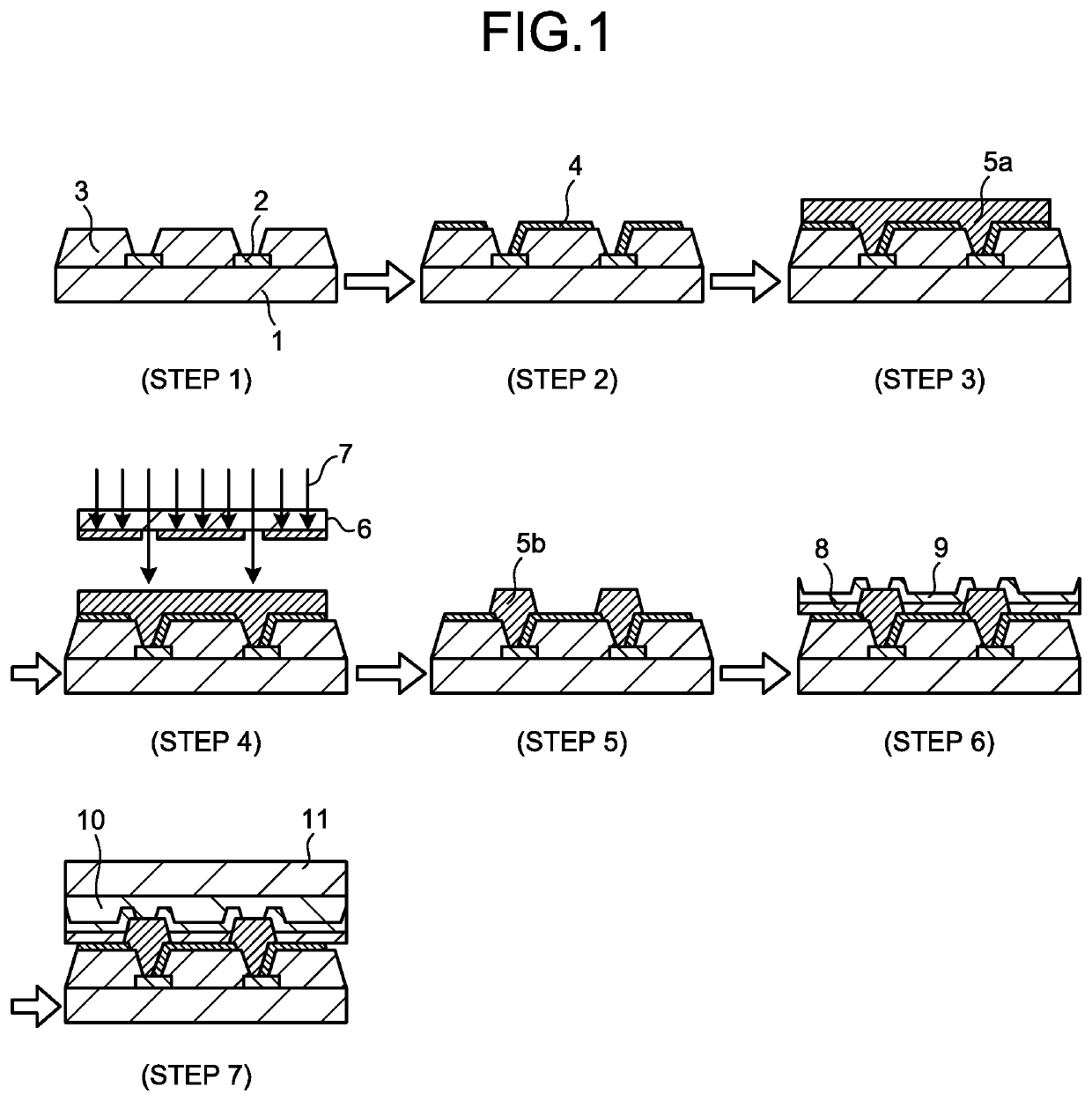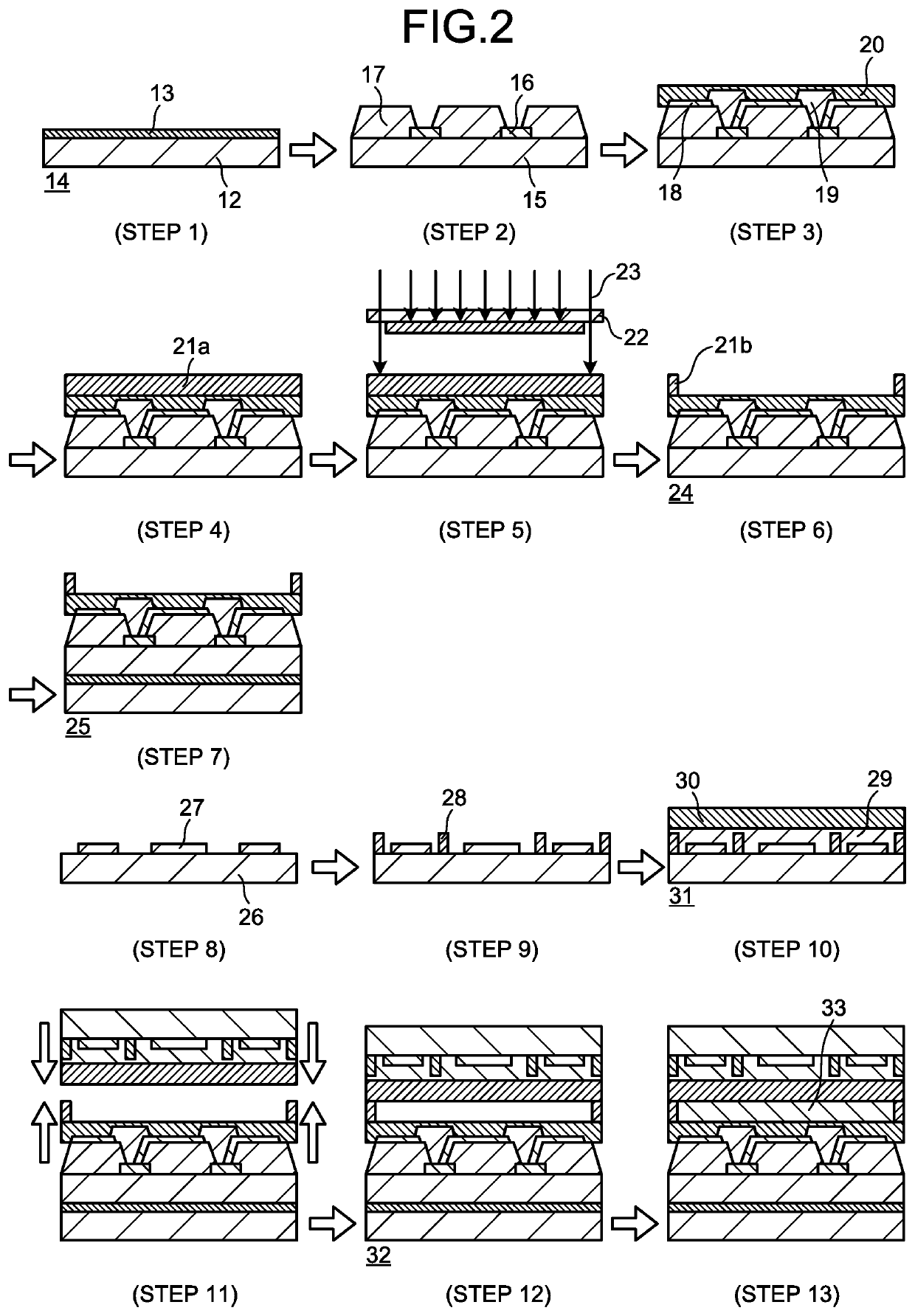Negative photosensitive resin composition, cured film, and organic el display and manufacturing method therefor
a technology of resin composition and negative photosensitivity, which is applied in the direction of azomethine-azo dyes, solid-state devices, anthracene dyes, etc., can solve the problems of reducing the lifetime of light-emitting elements, reducing visibility and contrast, and deteriorating the display characteristics and reliability of organic el displays, etc., to achieve excellent light-blocking properties, suppress the change of pattern opening width, and high sensitivity
- Summary
- Abstract
- Description
- Claims
- Application Information
AI Technical Summary
Benefits of technology
Problems solved by technology
Method used
Image
Examples
examples
[0482]The present invention will be described more specifically with reference to examples and comparative examples, but the present invention is not limited to the scope thereof. It is to be noted that here are names for the abbreviation used for some of the compounds used.
[0483]6FDA: 2,2-(3,4-dicarboxyphenyl)hexafluoropropane dianhydride; 4,4′-hexafluoropropane-2,2-diyl-bis(1,2-phthalic anhydride)
[0484]A-BPEF: “NK ESTER” (registered trademark) A-BPEF (manufactured by Shin Nakamura Chemical Co., Ltd.; 9,9-bis[4-(2-acryloxyethoxy)phenyl]fluorene)
[0485]A-DCP: “NK ESTER” (registered trademark) A-DCP (manufactured by Shin Nakamura Chemical Co., Ltd.; dimethylol-tricyclodecane diacrylate)
[0486]A-DPH-6E: “NK ESTER” (registered trademark) A-DPH-6E (manufactured by Shin Nakamura Chemical Co., Ltd.; ethoxylated dipentaerythritol hexaacrylate having 6 oxyethylene structures in the molecule)
[0487]APC: Argentum-Palladium-Cupper (silver-palladium-copper alloy)
[0488]BAHF: 2,2-bis(3-amino-4-hydro...
synthesis example (
A)
[0542]In a three-neck flask, 18.31 g (0.05 mol) of BAHF and 17.42 g (0.3 mol) of propylene oxide were dissolved in 100 mL of acetone weighed. Into this solution, a solution of 20.41 g (0.11 mol) of 3-nitrobenzoyl chloride dissolved in 10 mL of acetone was delivered by drops. After the completion of dropping, the solution was allowed to undergo a reaction for 4 hours at −15° C., and then, the temperature thereof was returned to room temperature. The precipitated white solid matter was filtered off, and subjected to vacuum dry at 50° C. In a 300 mL stainless-steel autoclave, 30 g of the obtained solid was placed, dispersed in 250 mL of 2-methoxyethanol, and 2 g of 5% palladium-carbon was added to the dispersion. Into the dispersion, hydrogen was introduced with a balloon, thereby allowing for a reaction at room temperature for 2 hours. After 2 hours, it was confirmed that the balloon is not squeezed any more. After completion of the reaction, the palladium compound as a catalyst was...
synthesis example 1
ide (PI-1)
[0543]Under a dry nitrogen stream, 31.13 g (0.085 mol; 77.3 mol % based on the structural units derived from all of amines and derivatives thereof) of BAHF and 1.24 g (0.0050 mol; 4.5 mol % based on the structural units derived from all of amines and derivatives thereof) of SiDA, 2.18 g (0.020 mol; 18.2 mol % based on the structural units derived from all of amines and derivatives thereof) of MAP as an end-capping agent, and 150.00 g of NMP were weight, and then dissolved in a three-neck flask. To this solution, a solution of 31.02 g (0.10 mol; 100 mol % based on the structural units derived from all of carboxylic acids and derivatives thereof) of ODPA dissolved in 50.00 g of NMP was added, stirred at 20° C. for 1 hour, and then 50° C. for 4 hours. Thereafter, 15 g of xylene was added thereto, and the solution was stirred for 5 hours at 150° C. while azeotroping the water with the xylene. After completion of the reaction, the reaction solution was poured into 3 L of water,...
PUM
| Property | Measurement | Unit |
|---|---|---|
| transmission wavelength | aaaaa | aaaaa |
| absorption wavelength | aaaaa | aaaaa |
| absorption wavelength | aaaaa | aaaaa |
Abstract
Description
Claims
Application Information
 Login to View More
Login to View More - R&D
- Intellectual Property
- Life Sciences
- Materials
- Tech Scout
- Unparalleled Data Quality
- Higher Quality Content
- 60% Fewer Hallucinations
Browse by: Latest US Patents, China's latest patents, Technical Efficacy Thesaurus, Application Domain, Technology Topic, Popular Technical Reports.
© 2025 PatSnap. All rights reserved.Legal|Privacy policy|Modern Slavery Act Transparency Statement|Sitemap|About US| Contact US: help@patsnap.com



